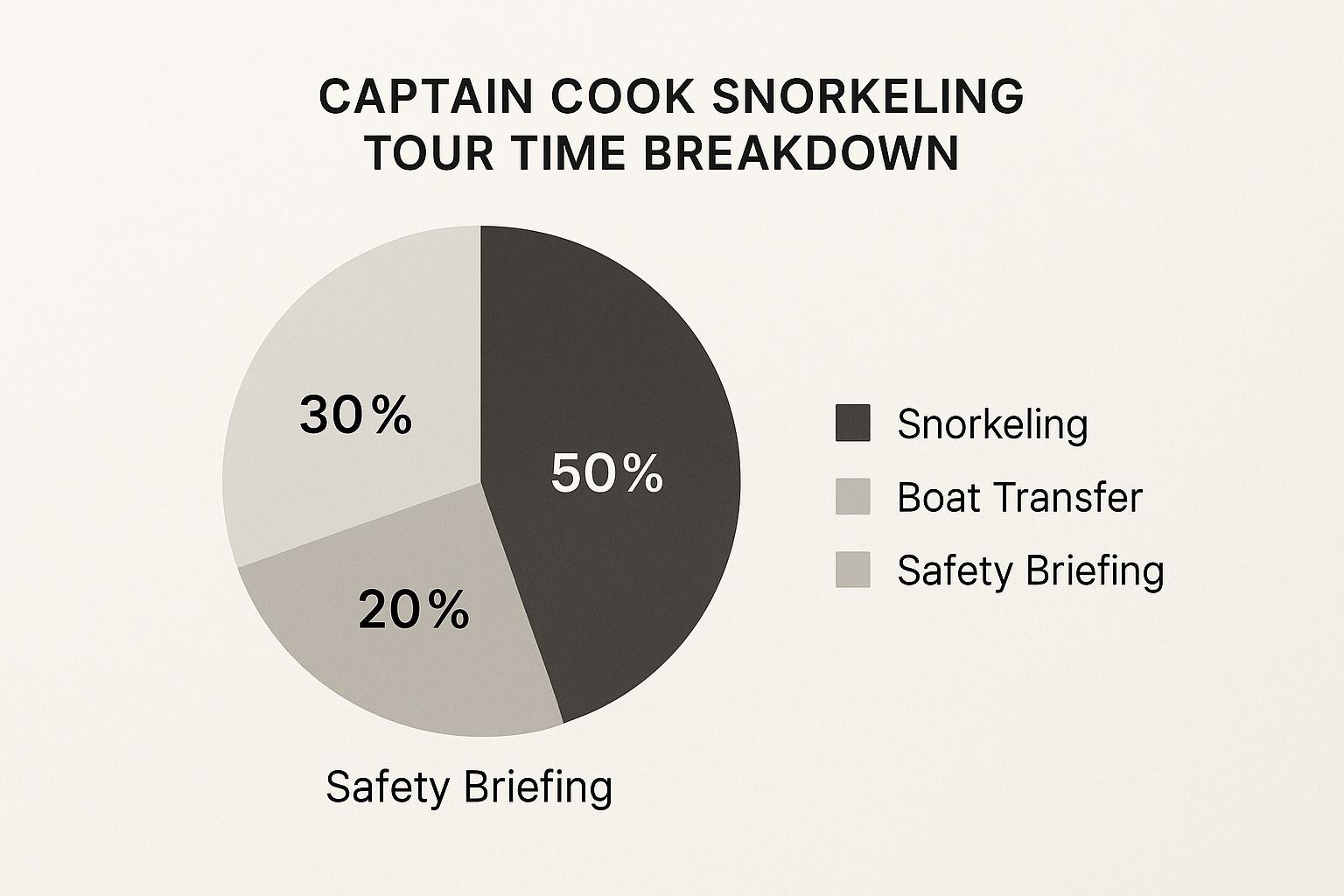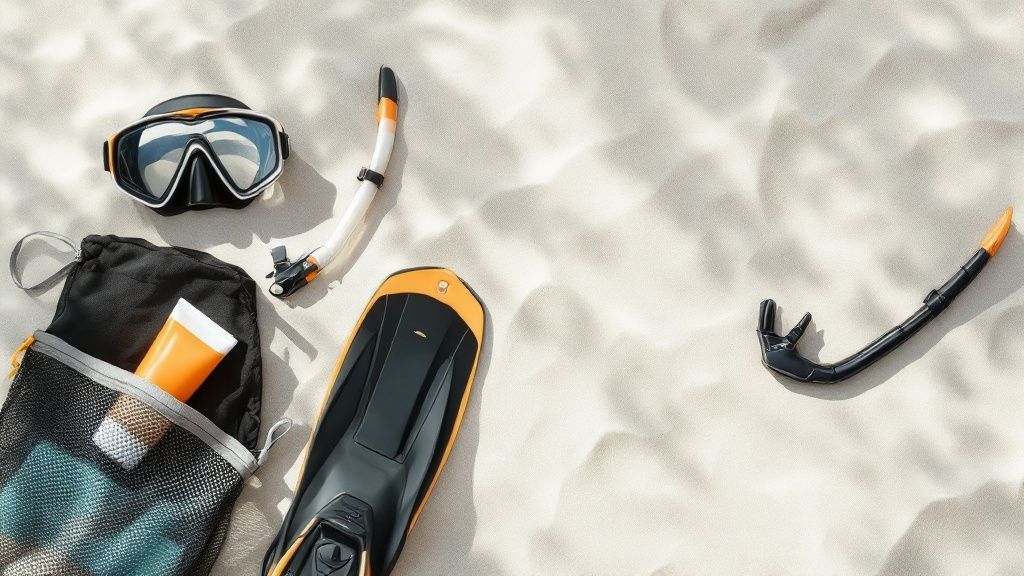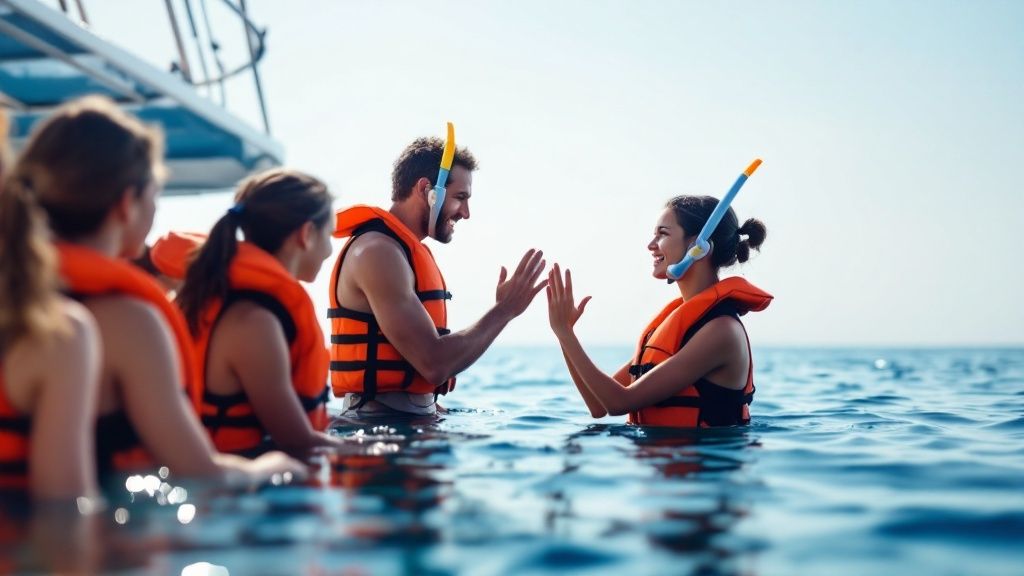The Living History of Kealakekua Bay's Waters
Kealakekua Bay isn't just a pretty place to snorkel; it's a captivating underwater museum. The bay holds deep historical importance, intrinsically linked to Captain James Cook's arrival. This makes a captain cook snorkeling tour a truly special experience.
His visit in 1779 wasn't just a brief stop; it marked the first documented Western contact with the Hawaiian Islands. This event forever changed the islands' trajectory. While ultimately tragic, this encounter set the stage for the cultural exchange and global fascination that shapes the bay we see today.
A First Encounter and a Lasting Impression
Captain Cook's arrival began a period of significant transformation for Hawaii. This moment signaled the start of Western influence and the documentation of the bay's natural beauty.
His naturalists meticulously documented the vibrant marine life, creating the first Western descriptions of the very reefs snorkelers explore now. These early records offer a compelling look into the bay’s past, allowing us to appreciate the ecosystem's resilience.
Over two centuries later, the bay's coral gardens thrive, hosting over 200 fish species. Parrotfish and yellow tang are just a few of the vibrant inhabitants you might encounter, all flourishing in waters protected by Hawaii's conservation efforts. Before the pandemic, the site saw an estimated annual visitation growth of 5-10%, demonstrating its lasting appeal as both a historical and ecological treasure. Learn more about this history here: Captain Cook Hawaii Snorkeling
Exploring the Depths of Time
Today, a captain cook snorkeling tour allows you to personally connect with this past. As you explore the clear waters, imagine Cook's ships navigating the same bay centuries ago.
This tangible link to history enriches the snorkeling experience, adding a layer of meaning to your underwater exploration. It’s more than just observing marine life; it’s a journey through time.
Choosing Your Own Historical Adventure
Several tour operators offer distinctive ways to experience this historic location. Captain Cook Snorkeling Tours provides a focused experience, emphasizing the bay's historical significance.
For a wider perspective, Kona Honu Divers offers excursions that combine the bay’s historical context with explorations of the surrounding areas. This approach deepens your understanding of the region's interconnected ecosystems and cultural heritage.
Carefully choosing the right tour allows you to create a personalized adventure that best suits your interests and leaves you with lasting memories. It enhances your appreciation for the unique blend of history, culture, and natural beauty that defines Kealakekua Bay.
Why Kealakekua Bay Outshines All Hawaiian Snorkeling Spots

Kealakekua Bay consistently ranks as a top snorkeling destination in Hawaii, and it's easy to see why. A Captain Cook snorkeling tour offers an unforgettable experience, blending natural beauty, historical significance, and thriving marine life. The bay's protected status as a marine sanctuary is key to its pristine condition. This creates a haven for diverse marine life, making it perfect for both new snorkelers and experienced enthusiasts.
Exceptional Visibility and Pristine Coral
Kealakekua Bay offers exceptional visibility, frequently exceeding 100 feet. This incredible clarity lets you see the vibrant colors and intricate details of the coral reefs below. The coral formations are a major draw, largely untouched by mass tourism. These healthy reefs are home to a multitude of marine species, creating a truly breathtaking underwater world.
Unmatched Biodiversity: A Marine Life Hotspot
This protected bay is a biodiversity hotspot, teeming with a variety of fish, coral, and other marine life rarely seen elsewhere in Hawaii. This abundance is directly related to the bay’s protected status, limiting human impact and allowing the ecosystem to thrive. You're likely to see colorful parrotfish, schools of yellow tang, and even green sea turtles. Each snorkeling trip promises exciting new discoveries.
A Historical Landmark Beneath the Waves
Captain James Cook's 1779 arrival in Kealakekua Bay profoundly impacted Hawaiian history, linking cultural exchange with the bay's current appeal. Cook's encounter with native Hawaiians adds another layer of significance to this special place, marked by a monument. The bay's dual role as a historical landmark and marine sanctuary attracts visitors globally, seeking natural beauty and cultural understanding. Today, Kealakekua Bay attracts over 100,000 snorkelers annually, drawn by its clear waters and thriving reefs. For more detailed statistics, check out: Captain Cook Snorkeling.
Microclimate and Year-Round Snorkeling
The bay's unique microclimate provides favorable snorkeling conditions throughout the year. This means visitors can enjoy its beauty regardless of the season. This consistency and accessibility make it a rewarding destination for all skill levels. Interested in planning a visit? Check out: Top 3 Best Kealakekua Bay Snorkeling Tours. Excellent tour operators like Captain Cook Snorkeling Tours and Kona Honu Divers offer fantastic experiences in these remarkable waters.
Selecting Your Perfect Captain Cook Snorkeling Experience

Choosing the right Captain Cook snorkeling tour can significantly enhance your time exploring Kealakekua Bay. With a variety of tour operators available, understanding their differences is crucial for a truly memorable experience. Think about the boat, the group size, and what amenities are included. For more information on Kona snorkeling tours, check out Kealakekua Bay Snorkeling.
Tour Operators: A Closer Look
Two great options for your snorkeling adventure are Captain Cook Snorkeling Tours and Kona Honu Divers. Captain Cook Snorkeling Tours focuses specifically on Kealakekua Bay, providing an in-depth experience of this historic site.
Kona Honu Divers offers more flexibility, with trips to Kealakekua Bay and other nearby snorkeling locations. This makes them a great option if you're interested in exploring multiple spots.
Factors to Consider for Your Tour
Besides the tour company, think about your ideal snorkeling experience. Do you prefer a smaller, more personalized tour, or a larger, more social outing?
-
Vessel Type: Some tours use smaller boats, allowing access to shallower waters, while others utilize larger catamarans offering increased stability and amenities.
-
Group Size: Smaller groups allow for more individualized attention from the guides, while larger groups offer a more lively atmosphere.
-
Inclusions: Check what’s included in the tour price, like snorkeling gear, meals, drinks, and restrooms.
Visualizing Tour Options: A Data Chart
To help you compare, the data chart below provides a quick overview of several popular tour operators, highlighting price ranges, group sizes, and amenities. This data chart visualizes the average price, group size, and amenities offered by several tour operators.

The data chart reveals insights into pricing trends and amenity variations across different tour operators. For instance, Captain Cook Snorkeling Tours averages around $120 per person with groups of 20-25 people and basic amenities. Kona Honu Divers averages around $150 with 10-15 people and standard amenities.
| Tour Operator | Price Range | Tour Duration | Group Size | Amenities | Special Features |
|---|---|---|---|---|---|
| Captain Cook Snorkeling Tours | $110 – $130 | 2-3 hours | 20-25 | Basic Snorkeling Gear, Life Jackets | Focus on Kealakekua Bay History |
| Kona Honu Divers | $140 – $160 | 3-4 hours | 10-15 | Standard Snorkeling Gear, Light Refreshments, Restrooms | Multiple Snorkeling Locations |
| Fair Wind Cruises | $160 – $180 | 5 hours | 30-40 | Full Meal, Bar, Waterslides | Large Catamaran, Family-Friendly |
| Body Glove Cruises | $130 – $150 | 4 hours | 20-30 | BBQ Lunch, Snorkeling Gear, | Manta Ray Night Snorkel (Separate Tour) |
This table summarizes key information, making it easier to choose the best snorkeling experience for your budget and preferences. Smaller groups generally correlate with higher prices, highlighting the trade-off between a more intimate experience and cost.
Underwater Encounters: Kealakekua Bay's Living Treasures
Kealakekua Bay isn't just a place of historical significance; it's a thriving underwater paradise. Booking a Captain Cook snorkeling tour offers an unparalleled glimpse into this vibrant ecosystem. The bay's protected status ensures the coral reefs flourish, providing a sanctuary for a diverse range of marine species. This makes it a truly exceptional snorkeling destination.
A Kaleidoscope of Reef Fish
The reefs of Kealakekua Bay are a riot of color. Schools of bright yellow tang dart through the water, their vibrant bodies contrasting beautifully with the deep blue. These fish are vital to the reef's health, diligently consuming algae that could otherwise overwhelm the coral. Equally important are the parrotfish, their beak-like mouths scraping algae and dead coral, promoting new growth. Their striking colors add to the underwater rainbow. With a bit of luck, you might even spot the elusive Hawaiian octopus, its masterful camouflage tested as it navigates the coral's nooks and crannies.
Gentle Giants and Playful Dolphins
Kealakekua Bay also hosts larger marine creatures. Graceful green sea turtles glide through the water, often allowing snorkelers a close-up encounter. These turtles are a testament to the bay's healthy ecosystem. Spinner dolphins, known for their playful antics and acrobatic leaps, are frequent visitors. Observing these intelligent creatures in their natural environment is a memorable experience. Occasionally, the truly magnificent manta rays make a grand appearance, their vast wingspans an awe-inspiring sight.
Respectful Wildlife Interaction
Preserving this fragile ecosystem is crucial for future generations. Responsible tour operators like Captain Cook Snorkeling Tours and Kona Honu Divers prioritize respectful wildlife interaction. This means maintaining a safe distance from the animals, refraining from touching or feeding them, and avoiding flash photography. These practices help ensure the bay remains a sanctuary for its inhabitants. For those eager to explore more of the Big Island's dive sites, check out the best shore diving in Kona, Hawaii.
Capturing the Magic: Underwater Photography Tips
Documenting your underwater adventure is a fantastic way to share the experience. However, responsible photography is paramount. Natural light is best, capturing the reef's true colors without disturbing marine life. Adjusting your camera settings to compensate for the water's light filtering effect can help capture the vibrancy of the coral and fish. Patience is key. Taking the time to observe the animals and anticipate their movements will result in more captivating shots. Remember, the goal is to document, not disrupt, this precious underwater world.

Using reef-safe sunscreen helps protect the coral from harmful chemicals, contributing to a sustainable snorkeling experience. By adhering to these guidelines, you can help preserve this incredible bay for years to come.
Balancing Paradise: Tourism's Impact on Kealakekua Bay

Kealakekua Bay, a vibrant ecosystem teeming with life, attracts thousands of visitors yearly. Many are drawn to the area for its exceptional Captain Cook snorkeling tours. This influx of tourism presents a unique challenge: how to balance the economic advantages with the potential environmental consequences.
The popularity of these tours brings crucial revenue to local Hawaiian communities. It supports businesses and creates jobs, bolstering the local economy. However, this same popularity can put a strain on the delicate balance of the bay’s ecosystem. Finding a sustainable approach is key to preserving this special place.
Kealakekua Bay's Captain Cook snorkeling tours attract approximately 190,000 visitors annually, significantly contributing to Hawaii's tourism economy. These tours generate millions in revenue, supporting a range of businesses from boat operators to local hospitality services.
This rise in eco-tourism coincides with the bay's designation as a protected marine sanctuary. This highlights ongoing efforts to preserve its coral reefs and unique species, including the Hawaiian spinner dolphin. Learn more about the impact of tourism on Kealakekua Bay here.
Protecting the Bay: Conservation Efforts
Recognizing the importance of preserving this natural wonder, responsible tour operators have implemented important conservation measures. Many now require the use of reef-safe sunscreen. This minimizes the amount of harmful chemicals entering the water and potentially damaging the fragile coral.
Advanced mooring systems have also been adopted, replacing traditional anchors. Traditional anchors can scar the reef, causing long-term damage. These combined efforts demonstrate a commitment to sustainable tourism practices.
Collaborative Partnerships for Sustainability
Innovative partnerships have emerged between tour companies, research institutions, and native Hawaiian cultural organizations. These collaborations are focused on developing and implementing long-term sustainability initiatives.
Some tours now incorporate educational components, teaching visitors about the bay’s unique ecology and cultural significance. This helps foster a sense of responsibility among visitors, encouraging them to be mindful of their impact on the environment. You might also be interested in Why You Should Consider Scuba Diving Hawaii.
Choosing a Responsible Tour Operator
Selecting a responsible tour operator for your Captain Cook snorkeling tour is crucial. Reputable companies, such as Captain Cook Snorkeling Tours and Kona Honu Divers, actively engage in conservation practices and community support.
These companies promote sustainable tourism by educating guests and adhering to responsible operating procedures. This conscientious approach ensures the bay’s beauty can be enjoyed by generations to come.
Minimizing Your Footprint
As a visitor, you can contribute to the preservation of Kealakekua Bay. By choosing responsible tour operators like Captain Cook Snorkeling Tours or Kona Honu Divers, you directly support companies invested in sustainability.
Using reef-safe sunscreen, respecting marine life, and following the guidelines provided by your tour guides can significantly reduce your individual impact. These small, conscious actions collectively contribute to the long-term health and vitality of this beautiful bay. By taking a proactive approach, we can all help balance the pleasure of exploring this unique environment with the responsibility of protecting it.
Your Captain Cook Snorkeling Adventure Blueprint
Getting ready for a Captain Cook snorkeling tour? A little planning can transform your Kealakekua Bay trip from ordinary to extraordinary. This guide, drawing on advice from tour captains, marine safety experts, and regular bay visitors, provides everything you need for a successful snorkeling adventure.
Timing Is Everything: Optimal Conditions for Snorkeling
Picking the right time for your Captain Cook snorkeling tour can greatly enhance your experience. The best months for calm waters and clear visibility are generally during the summer, from May to September. However, thanks to its sheltered location, the bay offers great snorkeling year-round.
For the most striking light and underwater views, consider a morning tour. The early morning sun illuminates the reef, bringing the coral and fish to life. This is particularly helpful for underwater photography.
Essential Gear for a Smooth Snorkeling Trip
The right gear can make all the difference in your snorkeling experience. Reef-safe sunscreen is vital, protecting both your skin and the delicate coral. A well-fitting mask and snorkel are crucial for comfortable breathing and clear underwater vision.
To help you pack, we've put together a handy checklist of essential and optional items:
Before we dive in, let's take a look at a checklist to help you pack for your adventure. This table outlines the essential and optional items you might need for a memorable snorkeling experience.
| Category | Essential Items | Optional Items | Notes |
|---|---|---|---|
| Personal Gear | Reef-safe sunscreen, Swimsuit, Towel | Hat, Sunglasses, Water shoes | Pack light, but don't forget sun protection. |
| Snorkeling Gear | Mask, Snorkel, Fins | Dry snorkel, Underwater camera | Rent or bring your own; quality makes a difference. |
| Other | Waterproof bag, Seasickness medication (if prone) | Underwater housing for phone, Binoculars | Protect valuables; be prepared for potential discomfort. |
This checklist should help you pack efficiently and ensure you have everything you need for a comfortable and enjoyable snorkeling trip.
Managing Common Snorkeling Challenges
Even experienced snorkelers encounter occasional issues. Mask fogging is easily prevented with defogging solution or a simple trick like spitting inside the mask and rinsing it before entering the water.
Seasickness can be managed with over-the-counter medication or natural remedies like ginger. Staying towards the middle of the boat can also help. For additional advice, consult our guide on Scuba Diving Hawaii.
Special Considerations for Different Groups
Kealakekua Bay welcomes snorkelers of all ages and abilities, but some groups may need extra planning. For families with young children, look for tours with life vests and guides experienced with kids. Older adults and less confident swimmers may prefer calmer, shallower areas accessible from the shore or smaller boats.
Choosing Your Ideal Tour Operator
Captain Cook Snorkeling Tours is an excellent choice known for their historical focus. Kona Honu Divers is another great option, offering a range of tours for different skill levels.
By understanding your options and preparing accordingly, you can ensure a safe, comfortable, and truly memorable Captain Cook snorkeling tour. Explore Hawaii's vibrant underwater world with Kona Honu Divers, offering excellent scuba diving and snorkeling tours. Book your unforgettable adventure today!
